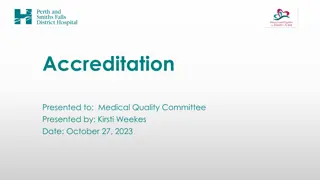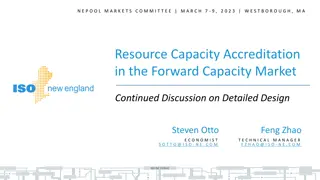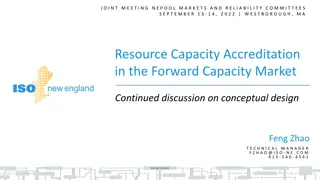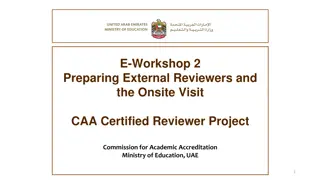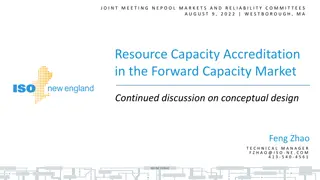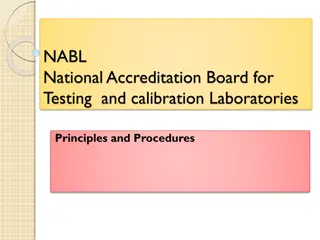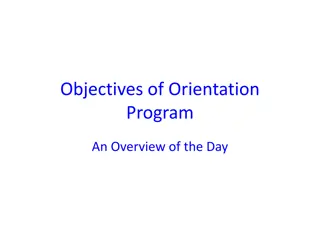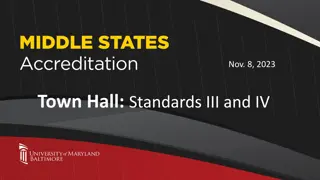Proposal for Resource Capacity Accreditation in Forward Capacity Market
The ISO-NE has proposed improvements to the accreditation processes in the Forward Capacity Market (FCM) through the Resource Capacity Accreditation (RCA) project. The aim is to enhance the accreditation of resource contributions to ensure reliability during the transition to a cleaner energy mix. The presentation outlines the conceptual design, capacity accreditation model enhancements, and introduces the MRI-based accreditation and market design. Stakeholder engagement and opportunities for improvements are also highlighted.
Download Presentation

Please find below an Image/Link to download the presentation.
The content on the website is provided AS IS for your information and personal use only. It may not be sold, licensed, or shared on other websites without obtaining consent from the author. Download presentation by click this link. If you encounter any issues during the download, it is possible that the publisher has removed the file from their server.
E N D
Presentation Transcript
J O I N T M E E T I N G N E P O O L M A R K E T S A N D R E L I A B I L I T Y C O M M I T T E E S J U L Y 1 2 , 2 0 2 2 | M E R E D I T H , N H Resource Capacity Accreditation in the Forward Capacity Market MRI-based conceptual design Feng Zhao T E C H N I C A L M A N A G E R F Z H A O @ I S O - N E . C O M 4 1 3 - 5 4 0 - 4 5 6 1 ISO-NE PUBLIC
WMPP ID: 157 Resource Capacity Accreditation in the Forward Capacity Market Proposed Effective Date: FCA 19 The Resource Capacity Accreditation (RCA) project proposes improvements to ISO-NE s accreditation processes in the Forward Capacity Market (FCM) to further support a reliable, clean-energy transition by implementing methodologies that will more appropriately accredit resource contributions to resource adequacy as the resource mix transforms ISO-NE PUBLIC 2
WMPP ID: 157 Resource Capacity Accreditation in the Forward Capacity Market Proposed Effective Date: FCA 19 The ISO has made a commitment to FERC to file proposed improvements in time for FCA 19 This presentation describes the ISO-NE s conceptual design on capacity accreditation and will be discussed over the next few joint MC/RC meetings Graphs and numerical examples do not reflect estimates of the impacts of potential reforms but are merely stylized examples ISO-NE PUBLIC 3
WMPP ID: 157 Resource Capacity Accreditation in the Forward Capacity Market Proposed Effective Date: FCA 19 Today s discussion will focus on: Review opportunities for improvements (slides 6-8) Overview of the RCA improvements (slides 10-14) The MRI concept (slides 16-22) Introduce adequacy assessment model enhancements (slides 24-29) Introduce the MRI-based accreditation and market design (slides 31-50) Conclusion (slides 52-53) Stakeholder schedule (slides 55-58) ISO-NE PUBLIC 4
OPPORTUNITIES FOR IMPROVEMENTS TO CURRENT CAPACITY ACCREDITATION PROCESS ISO-NE PUBLIC ISO-NE PUBLIC 5
From June 7-8 presentation Forward Capacity Market Design Objectives Design Objective 1: To ensure the system has sufficient resources to meet the region s one-day-in-ten reliability requirement, where sufficient is defined as having enough resources that can perform as expected in the right locations Design Objective 2: To ensure that Design Objective 1 is achieved in a cost-effective manner Design Objectives 1 and 2 are the current objectives for the FCM, which the RCA reforms must also meet ISO-NE PUBLIC 6
Clean Energy Transition Objective The region is moving swiftly toward a decarbonized grid. There are opportunities to implement improvements now to better facilitate reliability and market efficiency in the future The ISO is proposing improvements to our current resource adequacy assessment and accreditation processes to better ensure that the FCM continues to meet Design Objectives 1 and 2 as well as the objective to actualize our vision for the evolving clean-energy resource mix ISO-NE PUBLIC 7
Opportunities for Improvement Opportunity #1: Current capacity accreditation framework can be improved to reflect different resource contributions toward resource adequacy. These adjustments will better yield accredited capacity that is substitutable between resources, which is beneficial as unique resource types enter the market Opportunity #2: Current resource adequacy assessment process can be improved to better reflect resources expected performance and reliability contributions as the resource mix changes ISO-NE PUBLIC 8
OVERVIEW OF CONCEPTUAL DESIGN FOR RCA IMPROVEMENTS ISO-NE PUBLIC ISO-NE PUBLIC 9
Our Responses to Improvement Opportunities RCA Improvement #1: Accredit all resources based on their marginal reliability impact to yield substitutability between resources (Response to Opportunity 1) RCA Improvement #2: Improve resource adequacy assessment modelsfor more accurate resource MRI and accredited values (Response to Opportunity 2) ISO-NE PUBLIC 10
RCA Improvement #1: MRI-based Accreditation Each resource s Marginal Reliability Impact (MRI), in hours/year, is evaluated prior to FCA Each resource s relativeMarginal Reliability Impact (rMRI) to perfect capacity is a ratio (no units): rMRI = MRI/MRIperfect Each resource s new accredited capacity, Qualified MRI Capacity (QMRIC), is calculated in MW: QMRIC = QC rMRI rMRI Qualified Capacity (QC) Qualified MRIC (QMRIC) ISO-NE PUBLIC 11
RCA Improvement #1: MRI-based Accreditation cont. Two obligations are produced by market clearing The new Capacity Supply Obligation (CSO) or cleared MRIC, and Effective CSO (ECSO), the physical obligation associated with the CSO FCM Clearing Physical & market obligations Current: CSO QC Physical obligation QC ECSO New: 1/rMRI rMRI FCM Clearing Market obligation CSO QMRIC ISO-NE PUBLIC 12
RCA Improvement #2: Adequacy Assessment Model Improvement Resource MRI values are calculated using GE-MARS, a resource adequacy assessment tool MRIs are affected by the resource adequacy assessment models of load and resources in GE-MARS Resource adequacy assessment models are enhanced to allow more accurate calculation of resources MRI values ISO-NE PUBLIC 13
Connection to Previous FCM Improvements Zonal Demand Curves RCA introduces the MRIconcept to supply-side of FCM MRI-based Demand Curve MRI-based Resource QC accreditation Accreditation ISO-NE PUBLIC 14
THE MRI CONCEPT ISO-NE PUBLIC ISO-NE PUBLIC 15
Introduction As noted in June, the ISO has been finding the marginal approach most compelling Conceptually marginal ELCC and MRI-based accreditation yield the same results under the same reliability metric The ISO already implemented the MRI concept in its capacity demand curves (demand-side) This presentation introduces the MRI concept to resource capacity accreditation (supply-side) ISO-NE PUBLIC 16
MRI Concept The MRI of a resource reflects how a small change to the resource capacity ( C) would affect the system reliability in terms of changing Expected Unserved Energy ( EUE): MRI = EUE / C hours/year MWh/year MW The MRI concept has been applied in the ISO s demand MRI curves, e.g., system demand MRI is calculated as the EUE change with respect to a small change of the system capacity ISO-NE PUBLIC 17
Choice of EUE in MRI Definition EUE is selected as the reliability metric in MRI definition since it fits in the economic framework of FCM it is consistent with capacity demand curve construct it supports more accurate calculation of marginal values Both LOLE and EUE are used by the ISO to achieve a reliable system in a cost-effective manner ISO-NE PUBLIC 18
Interpretation of MRI MRI generally reflects a resource s expected availability (in hours/year) during reliability hours in the adequacy assessment, e.g., a resource would have zero MRI value if it is always unavailable MRI value equal to the expected number of reliability hours if it is always available at full capacity like the perfect capacity Reliability hours are times in adequacy assessments that additional capacity would improve system reliability ISO-NE PUBLIC 19
Factors Affecting a Resources MRI Value MRI can be affected by the resource s own characteristics, e.g., outage rate MRI can also be affected by the resource mix, e.g., penetration of the resource s class MRI is evaluated for a given resource mix Note that ELCC methods also rely on the resource mix assumption ISO-NE PUBLIC 20
Resource Mix for MRI Calculation The calculation of ICR and demand curves assumes the resource mix of the at-criterionICR base case We propose to use consistent resource mix assumptions for resource accreditation (supply side), ICR and demand curves (demand side) ISO-NE PUBLIC 21
Key Takeaways on MRI Concept MRI captures a resource s marginal contribution to the system reliability measured in EUE MRI generally reflects a resource s expected availability (in hours/year) when capacity is needed by the system MRI is affected not only by the resource s own characteristics, but also by the resource mix Resource MRIs and demand MRIs are calculated based on consistent resource mix assumptions from the ICR base case ISO-NE PUBLIC 22
ENHANCE ADEQUACY ASSESSMENT MODELS For More Accurate MRI Calculation ISO-NE PUBLIC ISO-NE PUBLIC 23
MRI Calculation In the last section, we showed that MRI is the EUE change in response to a small change to the resource s capacity In this section, we show how the MRI values can be calculated using the resource adequacy assessment tool and how the accuracy of these values can be improved ISO-NE PUBLIC 24
Resource Adequacy Assessment (RAA) for MRI Calculation Resource Adequacy Assessment (RAA), illustrated in the below figure, plays a critical role in calculating ICR and capacity demand curves In RAA, resource parameters such as Qualified Capacities (QCs) are inputs for evaluating the system reliability indices including EUE MRIs can be calculated by varying (increasing) a resource s QC and evaluating the EUE change Resource parameters (QC, EFORd, etc.) Load parameters RAA models (load and resources) Reliability metrics (EUE, LOLE, etc.) Probabilistic simulations Adequacy assessment tool (GE-MARS) ISO-NE PUBLIC 25
Enhance Load and Resource Models for Capacity Accreditation The load and resource models used in the adequacy assessment tool (GE-MARS) affect the accuracy of adequacy analysis result and MRI values We propose to enhance load and resource models for more accurate calculation of resource MRIs, within the limit of technical feasibility, software capability, and project schedule Details about the model enhancements will be discussed in the coming months and our conceptual direction follows in the next slides ISO-NE PUBLIC 26
Potential RAA Model Enhancements Potential RAA load enhancements The current load shape can be enhanced with a composite load shape reflecting representative summer and winter weather conditions for reliability studies Potential RAA resource model enhancements Intermittent resources such as solar and wind currently modeled as perfect capacity can be enhanced with hourly profiles Energy storage resources currently modeled as thermal units can be enhanced with energy storage models Gas-only resources currently modeled with unlimited gas supply can be enhanced with gas supply constraint ISO-NE PUBLIC 27
Calculating MRIs for Each Resource We propose to directly calculate individual resource MRIs, rather than calculating class values and allocating those class values to individual resources This allows more accurate characterization of a resource s reliability contribution than the class approach Resources not modeled in resource adequacy assessment can be assigned the corresponding class MRI of similar resources Class MRI is the QC-weighted average of all resource MRIs in the class ISO-NE PUBLIC 28
Key Takeaways on Adequacy Assessment Model Improvement MRIs can be calculated by perturbing resource QCs using the resource adequacy assessment tool Load and resource models in the resource adequacy assessment tool can be improved for more accurate calculation of resource MRI ISO-NE PUBLIC 29
THE MRI-BASED CAPACITY ACCREDITATION rMRI and Accredited Capacity ISO-NE PUBLIC ISO-NE PUBLIC 30
Using MRI for Capacity Accreditation The prior sections demonstrated how the MRI is defined and calculated In this section, we show how the MRI values can be used to translate resource QC into the new accredited value for the resource ISO-NE PUBLIC 31
Relative MRI By comparing each resource s marginal reliability impact to that of the perfect capacity s MRIperfect, the resource s relative Marginal Reliability Impact (rMRI) is represented by ???? = ???/?????????? rMRI of the perfect capacity is 1 (100%) rMRI allows each resource s capacity to be expressed in the same unit of perfect capacity, allowing for substitutability between resources ISO-NE PUBLIC 32
Illustrative Example for rMRI With rMRI, each MW of a resource s QC can be translated to an equivalent amount of perfect capacity Suppose resource A has MRIA = 4.5 hrs/yr, resource B has MRIB = 2.5 hrs/yr and MRIperfect = 5 hrs/yr; Then rMRIA = 4.5/5 = 90% and rMRIB = 2.5/5 =50% The translation of 1 MW of resource QC to perfect capacity is illustrated below Resource A Perfect Capacity Resource B 1 MW 1 MW 1 MW QC: rMRIperfect rMRIA rMRIB 0.5 MW 1 MW QMRIC: 0.9 MW ISO-NE PUBLIC 33
Capacity Accreditation with rMRI Since each 1 MW of a resource s QC can be translated (in terms of marginal reliability impact) to (1 rMRI) MW of perfect capacity, the new accredited capacity for the resource, i.e., Qualified MRI Capacity (QMRIC),is (QC rMRI) in MW QMRIC reflects the total marginal reliability impact of the resource With rMRI, QC of each resource can be translated to the equivalent QMRIC amount of perfect capacity: rMRI QC QMRIC ISO-NE PUBLIC 34
Illustrative example for QMRIC Suppose that resource A with QCA = 100 MW and rMRIA = 90%, resource B with QCB =100 MW and rMRIB = 50% Resource QC can be translated to perfect capacity as follows: A QC QMRIC (in perfect capacity) 90 MW A A 100 MW 50 MW B B 100 MW ISO-NE PUBLIC 35
Substitutability Under MRI-based Accreditation Substitutability means that a MW of accredited capacity from different resources has the same reliability impact Substitutability allows the direct comparison of costs ($/kW- month) of different resources with disparate characteristics, improving market transparency and economic efficiency Each MW of QMRIC or accredited capacity from different resources has the same reliability impact as a MW of the perfect capacity MRIC is substitutable under MRI-based accreditation ISO-NE PUBLIC 36
MRI-based Accreditation Applies to All Resources The MRI-based accreditation applies to all resources The same accreditation method for all resources facilitates market transparency and fairness Applying different capacity accreditations for different resources distorts the substitutability between resources and harms economic efficiency ISO-NE PUBLIC 37
Key Takeaways on rMRI and QMRIC rMRI represents the relative MRI of a resource compared to the perfect capacity With rMRI, resources QC can be converted to QMRIC that represents the amount of equivalent perfect capacity QMRIC allows substitutability between resources The MRI-based accreditation applies to all resources ISO-NE PUBLIC 38
THE MRI-BASED CAPACITY ACCREDITATION Physical and Market Quantities ISO-NE PUBLIC ISO-NE PUBLIC 39
Capacity Quantities Under The New Design In the last section, we reviewed how resources are accredited based on their MRIs In this section, we discuss the physical and market quantities under the new accreditation ISO-NE PUBLIC 40
QC and QMRIC Under the New Accreditation QMRIC replaces QC as the new market quantity QMRIC of a resource reflects the maximum market quantity that the resource can bid into the market Resources submit QMRIC-based capacity offers in Descending Clock Auction (DCA) QC remains a physical quantity QMRIC is the QC adjusted by its marginal reliability impact, i.e., rMRI QC QMRIC (market) (physical) ISO-NE PUBLIC 41
ECSO and CSO Under the New Accreditation FCM clears the QMRIC-based market offers The cleared QMRIC MW is called Capacity Supply Obligation (CSO) FCM clearing price is the price for the cleared market quantity, CSO The physical quantity corresponding to CSO is named Effective CSO (ECSO) Relationship between ECSO and CSO: ECSO = CSO 1/rMRI 1/rMRI CSO (market) ECSO (physical) ISO-NE PUBLIC 42
Use of Physical and Market Quantities in FCM QC or ECSO is used for processes that require a physical quantity QMRIC or CSO is used for processes that require a market quantity Physical QC ECSO 1/rMRI rMRI FCM Clearing Market CSO QMRIC ISO-NE PUBLIC 43
Key Takeaways on Capacity Quantities The MRI-based accreditation yields new market quantities of QMRIC and CSO QC and ECSO are used as the physical quantity in certain FCM processes With rMRI, physical quantities can be translated to market quantities and vice versa ISO-NE PUBLIC 44
THE MRI-BASED CAPACITY ACCREDITATION Capacity Requirement and Demand Curves ISO-NE PUBLIC ISO-NE PUBLIC 45
Capacity Requirement and Demand Curves We have covered how the MRI concept is used to drive the proposed resource accreditation In this section, we explain conceptually how the capacity requirement and demand curves can be formed under the MRI-based accreditation ISO-NE PUBLIC 46
Capacity Requirement in MRIC Net Installed Capacity Requirement (Net ICR) represents the amount of total QC (physical quantity) that the system needs to meet the 1-in-10 criterion, for the resource mix in the ICR base case With rMRI, Net ICR in QC MW can be translated to the new capacity requirement based upon MRIC (market quantity) as illustrated below Requirement Net ICR MRIC Base case resource mix Perfect capacity ISO-NE PUBLIC 47
Substitutability Between Supply and Demand Capacities in MRIC With rMRIs translating both resource QCs and Net ICR to the perfect capacity equivalents, a MW of MRIC supplied by each resource satisfies a MW of MRIC requirement from a reliability contribution perspective Supply and demand capacities under the MRI-based design are substitutable ISO-NE PUBLIC 48
Capacity Demand Curves in MRIC The current capacity demand curves represent the marginal costs of reliability as a function of total system or zonal QC For any point on a capacity demand curve, the QC MW associated with the point can be translated to the QMRIC MW with the rMRI of the corresponding system or zone Capacity demand curves established using QC can be translated to demand curves based upon MRIC ISO-NE PUBLIC 49
Key Takeaways on Capacity Requirement and MRIC Demand Curves The current QC-based Net ICR and demand curves can be translated to MRIC-based capacity requirement and demand curves By applying the MRI concept and consistent resource mix assumptions to both supply and demand sides of FCM, the supply and demand will align properly ISO-NE PUBLIC 50




